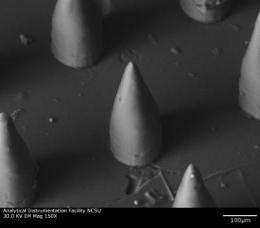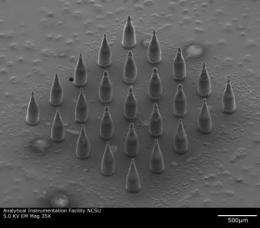New microneedle antimicrobial techniques may foster medical tech innovation

A team led by researchers from North Carolina State University has developed two new approaches for incorporating antimicrobial properties into microneedles - vanishingly thin needles that hold great promise for use in portable medical devices. Researchers expect the findings to spur development of new medical applications using microneedles.
Microneedles cause less pain, tissue damage and skin inflammation for patients, and could be a significant component of portable medical devices for patients with chronic conditions, such as Parkinson's disease or diabetes. However, longstanding concerns regarding the possibility of infection associated with microneedles have been an obstacle to their widespread adoption - until now.
The first new technique is for use with microneedles that would be incorporated into permanent or semi-permanent medical devices - such as glucose monitors for patients with diabetes. The researchers found that modifying the surface of a microneedle with an antimicrobial coating both prevented microbial growth and did not adversely affect skin cell growth. Researchers applied the coating using a laser-based vapor deposition process that created a thin film of silver (which is antimicrobial) on the microneedle surface.

The second approach is applicable to degradable microneedles, which are designed to dissolve on the skin surface and can be used for single-use drug delivery situations such as vaccine delivery. This technique involves incorporating an antimicrobial agent into the material used to make the microneedle itself. As the degradable microneedle dissolves it releases the antimicrobial agent, guarding against infection.
"We expect these findings to result in more widespread use of microneedles in outpatient treatments and technologies," says Dr. Roger Narayan, lead author of the research. "For example, microneedles could be used as a relatively pain-free and user-friendly alternative to conventional needles in diabetes treatment. They may also figure into new technologies pertaining to the delivery of anti-cancer drugs." Narayan is a professor in the joint biomedical engineering department of NC State's College of Engineering and the University of North Carolina at Chapel Hill.
More information: The research, "Two Photon Polymerization Of Microneedles For Transdermal Drug Delivery," will be presented May 24 at the First International Conference On Microneedles in Atlanta.


















